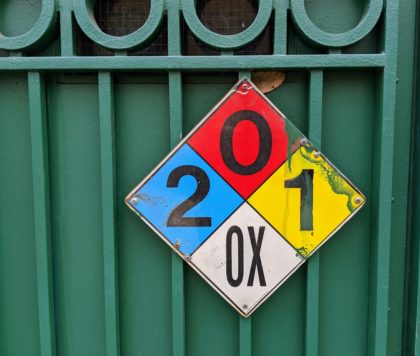Where in Tribeca?
I am hoping James can explain the meaning of these signs. In the meantime, where is this one?
…And, Robert Ripps got it. It’s Stuy. And thank you to James for being as reliable as ever. His thorough explanation of the meaning behind these signs below. My summary: on a scale of 0 to 4 with 4 being “deadly,” there is a #2 for a health hazard (must be chemicals in the labs); a 0 for flammability; a #1 for slightly hazardous reactivity; and an OX for oxidizer, something like oxygen, hydrogen peroxide and the halogens designed to get substances to accept electrons.
Those crazy kids!!
From James:
“The NFPA diamond provides a quick visual representation of the health hazard, flammability, reactivity, and special hazards that a chemical may pose during a fire.
“The NFPA diamond consists of four color-coded fields: blue, red, yellow, and white. The blue, red, and yellow fields—which represent health hazard, flammability, and reactivity, respectively—use a numbering scale ranging from 0 to 4. A value of 0 means that the material poses essentially no hazard, whereas a rating of 4 indicates extreme danger. The white field is used to convey special hazards.
“The National Fire Protection Association (NFPA) developed a hazard identification system for emergency responders that is still in use today. […]
“The NFPA diamond provides a quick visual representation of the health hazard, flammability, reactivity, and special hazards that a chemical may pose during a fire.
“The NFPA diamond consists of four color-coded fields: blue, red, yellow, and white. The blue, red, and yellow fields—which represent health hazard, flammability, and reactivity, respectively—use a numbering scale ranging from 0 to 4. A value of 0 means that the material poses essentially no hazard, whereas a rating of 4 indicates extreme danger. The white field is used to convey special hazards. […]
“NFPA Diamond (with four colors – blue, red, yellow and white)
NFPA Hazard Identification System
“BLUE Diamond Health Hazard
4 Deadly
3 Extreme Danger
2 Hazardous
1 Slightly Hazardous
0 Normal Material
‘RED Diamond Fire Hazard (Flash Point)
4 Below 73 °F
3 Below 100 °F
2 Above 100 °F Not Exceeding 200 °F
1 Above 200 °F
0 Will Not Burn
‘YELLOW Diamond Reactivity
4 May Detonate
3 Shock and Heat; May Detonate
2 Violent Chemical Change
1 Unstable if Heated
0 Stable
‘WHITE Diamond Special Hazard
ACID – Acid
ALK – Alkali
COR – Corrosive
OXY – Oxidizer
☢ – Radioactive
W – Use No Water”
Source: https://www.acs.org/content/acs/en/chemical-safety/basics/nfpa-hazard-identification.html















“The NFPA diamond provides a quick visual representation of the health hazard, flammability, reactivity, and special hazards that a chemical may pose during a fire.
“The NFPA diamond consists of four color-coded fields: blue, red, yellow, and white. The blue, red, and yellow fields—which represent health hazard, flammability, and reactivity, respectively—use a numbering scale ranging from 0 to 4. A value of 0 means that the material poses essentially no hazard, whereas a rating of 4 indicates extreme danger. The white field is used to convey special hazards.
“The National Fire Protection Association (NFPA) developed a hazard identification system for emergency responders that is still in use today. […]
“The NFPA diamond provides a quick visual representation of the health hazard, flammability, reactivity, and special hazards that a chemical may pose during a fire.
“The NFPA diamond consists of four color-coded fields: blue, red, yellow, and white. The blue, red, and yellow fields—which represent health hazard, flammability, and reactivity, respectively—use a numbering scale ranging from 0 to 4. A value of 0 means that the material poses essentially no hazard, whereas a rating of 4 indicates extreme danger. The white field is used to convey special hazards. […]
“NFPA Diamond (with four colors – blue, red, yellow and white)
NFPA Hazard Identification System
“BLUE Diamond Health Hazard
4 Deadly
3 Extreme Danger
2 Hazardous
1 Slightly Hazardous
0 Normal Material
‘RED Diamond Fire Hazard (Flash Point)
4 Below 73 °F
3 Below 100 °F
2 Above 100 °F Not Exceeding 200 °F
1 Above 200 °F
0 Will Not Burn
‘YELLOW Diamond Reactivity
4 May Detonate
3 Shock and Heat; May Detonate
2 Violent Chemical Change
1 Unstable if Heated
0 Stable
‘WHITE Diamond Special Hazard
ACID – Acid
ALK – Alkali
COR – Corrosive
OXY – Oxidizer
☢ – Radioactive
W – Use No Water”
Source: https://www.acs.org/content/acs/en/chemical-safety/basics/nfpa-hazard-identification.html
Thank you James!
Isn’t that on a gate door at Stuyvesant HS, on the West Street side of the building.
Indeed it is!
Oh! And here I thought it was the Tribeca outpost of Four Seasons Total Landscaping.
LOL
James certainly knows his stuff! And that goes for Robert Ripps
too! Great information.
I missed the compliment- thanks Sonia! And you’re no slouch yourself!
And thank you to James for being as reliable as ever. His thorough explanation of the meaning behind these signs in the post. My summary: on a scale of 0 to 4 with 4 being “deadly,” there is a #2 for a health hazard (must be chemicals in the labs); a 0 for flammability; a #1 for slightly hazardous reactivity (physics!); and an OX for oxidizer, something like oxygen, hydrogen peroxide and the halogens designed to get substances to accept electrons. Those crazy kids!